Workshop 9 posters
Digital poster session
The Epigraphy.info IX workshop will host poster session dedicated to the presentation of new and ongoing projects in the field of Digital Epigraphy. The poster session will be held in person, but also offer the possibility to present your poster virtually on the Epigraphy.info website during the workshop (where they will also remain publicly afterwards).
If you have any questions, please do not hesitate to contact the Epigraphy.info committee (info@epigraphy.info).
See all posters on Epigraphy.info GitHub
See the short video presentations on Epigraphy.info YouTube channel
List of posters:
- A topography of aretē: Mapping out the geographical and chronological spread of the concept of aretē (= virtue) in Greek inscriptions See poster
- Digital methods for inscriptions on bronze: a case study on 3D modelling and stereomicroscopy See poster
- From Manuscript to Digital: Digitization Strategies for the Marcanova Codex See poster
- We need a Digital Epigraphy manual. Reflections on teaching Digital Epigraphy to History students (who did not know about Epigraphy or Ancient Languages before) See poster
- TBA See poster
- NFDI4Objects Community Cluster (CC) Objects as Information Carriers See poster
- STTL Project See poster
- Altinum, a Wikidata project for Latin epigraphy and prosopography See poster
- The Wikibase instance ‘Greek Metrical Inscriptions’ See poster
- Epigraphy in situ in Ancient Liburnia and Iapodia: Contextualizing Epigraphic Formulae in the Northwestern Territories of Roman Dalmatia See poster
- La Lettera e il Leone: An Epigraphic Database of Venetian Renaissance Inscriptions from Cyprus See poster
- Graff-IT Digital Archive: The First Database on Medieval and Early Modern Graffiti in Italy See poster
- Building an epigraphic ontology See poster
1. ‘A topography of aretē: Mapping out the geographical and chronological spread of the concept of aretē (= virtue) in Greek inscriptions’
Antiopi Argyriou-Casmeridis (CHS Harvard University, Washington DC Summer Fellow 2024-2025; Postdoctoral Researcher National & Kapodistrian University of Athens)
antiopi_a@hotmail.com
Aretē is a core concept of the Greek paideia with a tenacity in literature and epigraphy throughout the ancient times. The inscription of aretē in such different contexts, as in funerary inscriptions, dedications, and honorific decrees, shows its manifold connotations of virtue, excellence, and other constituent aspects of virtues. Moreover, the geographical and chronological spread of inscribed aretē conveys the acknowledgement and dissemination of a koine of shared civic values and of a common shared language of virtue that were employed by various Greek poleis. In this respect, the epigraphical attestations of aretē reveal also the social, religious, professional, diplomatic and other exchanges and networks between Greek poleis in the Hellenistic and Imperial periods.
This poster is a presentation of an ongoing research project on the topography of aretē. It aims to explore the epigraphical attestations of aretē in Greek inscriptions dating from the Classical to the Roman Imperial periods (5th c. BC to 3rd c. AD). The primary goal of this project is to create a new digital open access searchable database of inscribed aretē. This project adopts an interdisciplinary method engaging epigraphy, ancient history, literature, linguistics, and digital Classics. It explores the manifold attestations of inscribed aretē in different types of inscriptions through the exploitation of already known digital tools and databases, with a view to providing metadata for the epigraphical data and contextualization of the epigraphic material.
Click here to see the full Poster 1 (PDF)
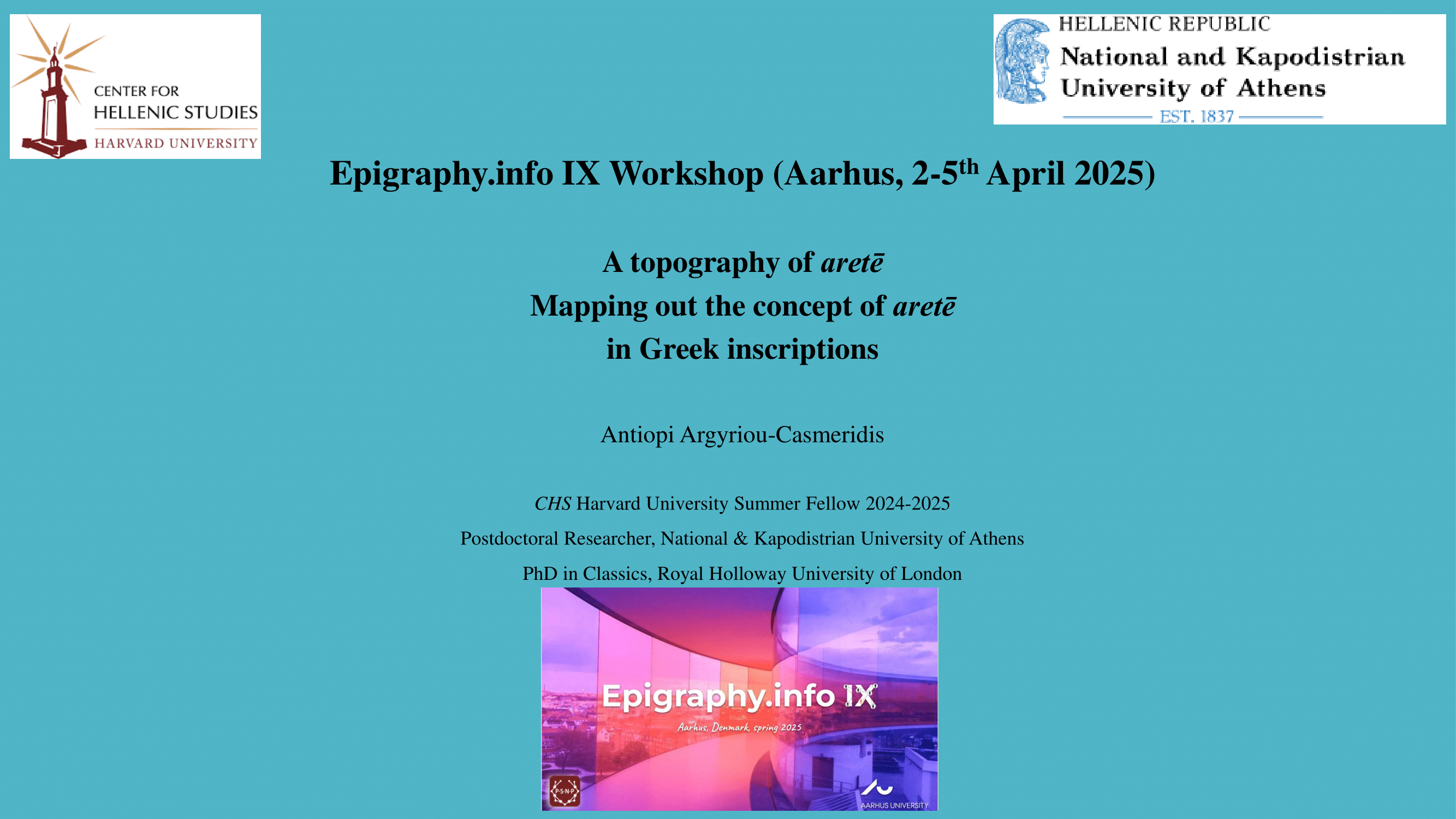
2. Digital methods for inscriptions on bronze: a case study on 3D modelling and stereomicroscopy
David Bartus, (ELTE Eötvös Loránd University)
bartus.david@btk.elte.hu
Brigetio is one of the most important Roman settlements in Pannonia. Several hundreds of high-quality bronze objects came from here, which make Brigetio the most important site for figural bronzes in Pannonia. However, the most important „world-famous” bronze object from Brigetio is not a figural one, but a bronze tablet found in 1930 containing the law of Constantine the Great and Licinius. The genre of the inscription – exemplum sacrarum litterarum – is exceptionally rare and only a few similar tablets are known from the Roman Empire, so it was quite striking when four fragments of a bronze tablet was found in 2014, just some meters away from the findspot of the first inscription. The fragments containing a previously unknown law issued by Philippus Arabs.
Different techniques were used during the analysis of the tablet. We used a Breuckmann 3D industrial white light scanner for creating 3D models of the bronze fragments, applying various textures on them to make the inscription easily readable. Changes of the lighting in the software also produced good results during the paleographical research. Stereomicroscopical images made by a Zeiss Discovery V8 helped us reconstructing the process of planning and engraving the text into the bronze material, and the shape of the tools used by the worker.
These digital techniques revealed the „biography” of the object: the name of Philippus Arabs was chiseled out from the tablet during its use, and traces of hammer strikes indicate that the four surviving fragments just avoided the recycling as scrap metal.
Click here to see the full Poster 2 (PDF)
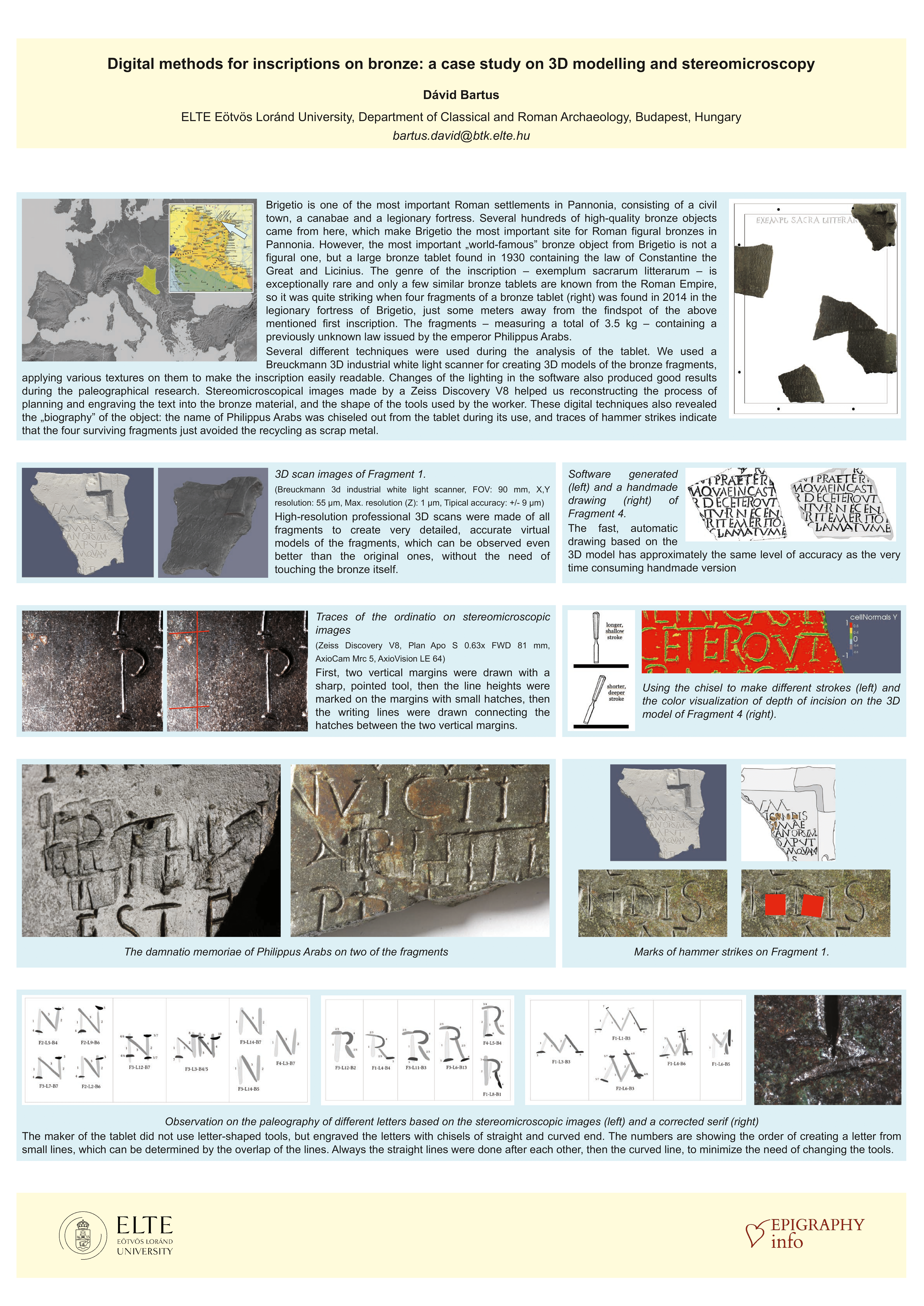
3. From Manuscript to Digital: Digitization Strategies for the Marcanova Codex (Cod. Lat. 992)
Alice Cicarelli (Independent researcher, digital poster)
https://zenodo.org/records/15035147
alicecicarelli@gmail.com
At the core of my project lies a strong interest in a Digital Humanities service offered by the Estense Library in Modena. The institution aims to enhance the value of its extensive collection using a new digital technology called IIIF, which enables high-resolution image viewing, searching, annotation, sharing, and manipulation. Another key feature is the “stories” tool: a digital storytelling feature that allows users to create narrative pathways with the available digital resources. This last feature proved particularly useful for the work I intended to carry out, which involved analyzing the transcribed inscriptions in the urban section of the manuscript Lat. 992 = α.L.05.15, known as the Marcanova codex, containing the second edition of Collectio Antiquitatum, an epigraphic anthology by Giovanni Marcanova. First, it was essential to identify the 377 inscriptions in this section, a task that presented challenges due to the frequent inaccuracy of the transcriptions and occasional “patchworks” of multiple inscriptions. Moreover, not all inscriptions were present in the online databases used for cross-referencing: for 46 of them, I personally handled the cataloging and entry into the EDR archive. Once the data was collected, it became necessary to consider the selection of information to include in the Estense Digital Library and the methods of doing so to achieve a level of accessibility for a broader audience, not exclusively specialists. The service is designed for scholars, enthusiasts, and educators, allowing these tools to be used in educational contexts as well.
Click here to see the full Poster 3 (PDF)
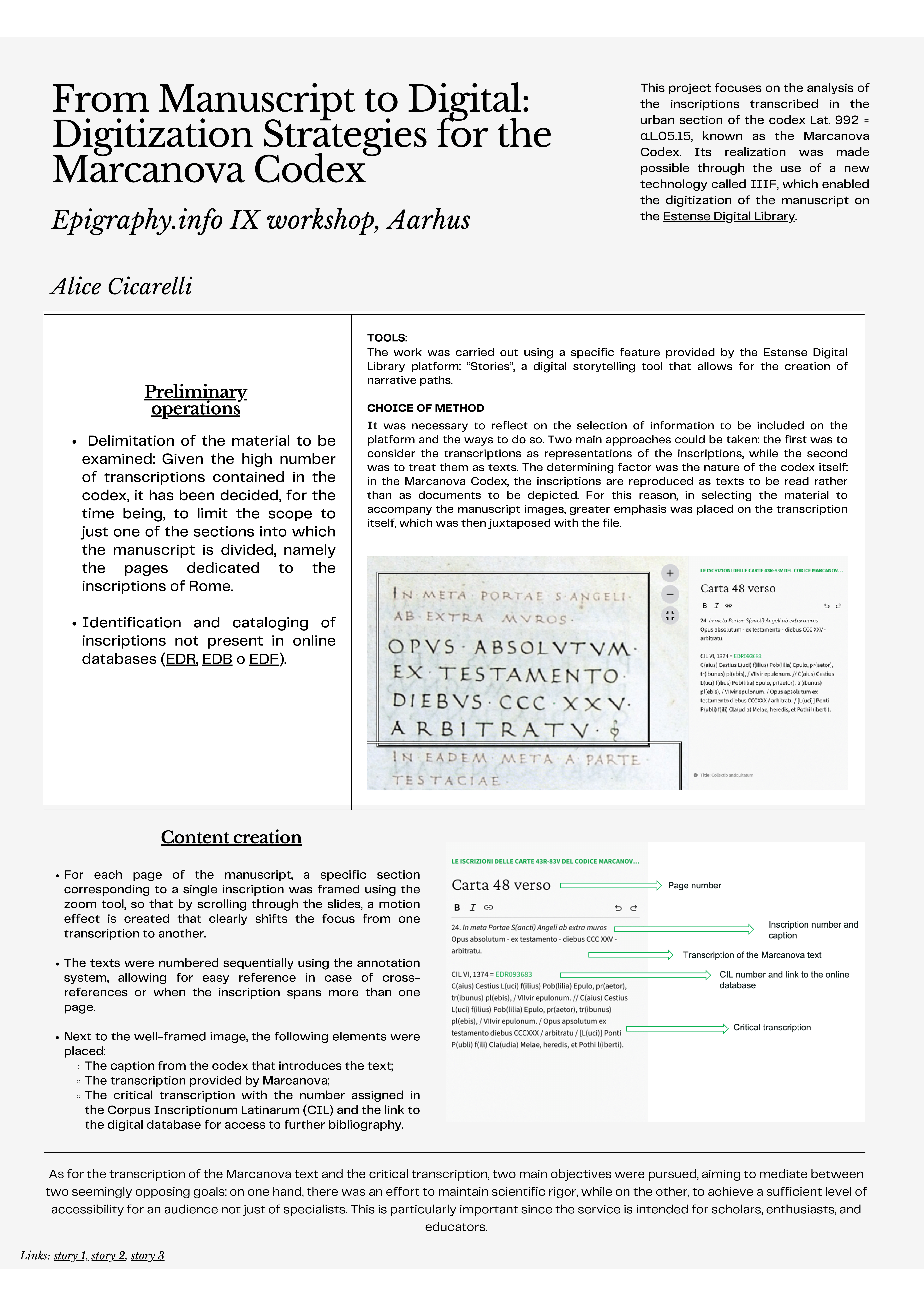
4. We need a Digital Epigraphy manual. Reflections on teaching Digital Epigraphy to History students (who did not know about Epigraphy or Ancient Languages before).
Elena Duce-Pastor (Autonoma University of Madrid), Cristina de la Escosura-Balbás (University of Alcalá)
elena.duce@uam.es
Ancient History students in Spain use Digital Epigraphy databases when working on their final thesis. However, they have little to no training in Epigraphy or its resources. The implementation of the Bologna Process removed Epigraphy from History degrees at Spanish universities. Therefore, History (BA) and Ancient History (MA) students are unable to reference, consult, and work properly with inscriptions and online databases. In this poster, we aim to present the seminaries we designed and conducted to mitigate the problem at the bachelor’s degree in History at U. of Alcala, the master’s degree in History and Ancient Sciences at the Autonomous U. of Madrid, and the master’s degree in Teacher Training (History and Geography) at U. of Alcala. Our findings show the necessity of a Digital Epigraphy manual (online, free, collaborative, updated, “DOIDed”); the value of teaching Epigraphy through Digital Epigraphy (especially for Archaeology and History students who rarely know Greek and Latin); and our DBs as instruments to connect with Heritage by people.
Click here to see the full Poster 4 (PDF)
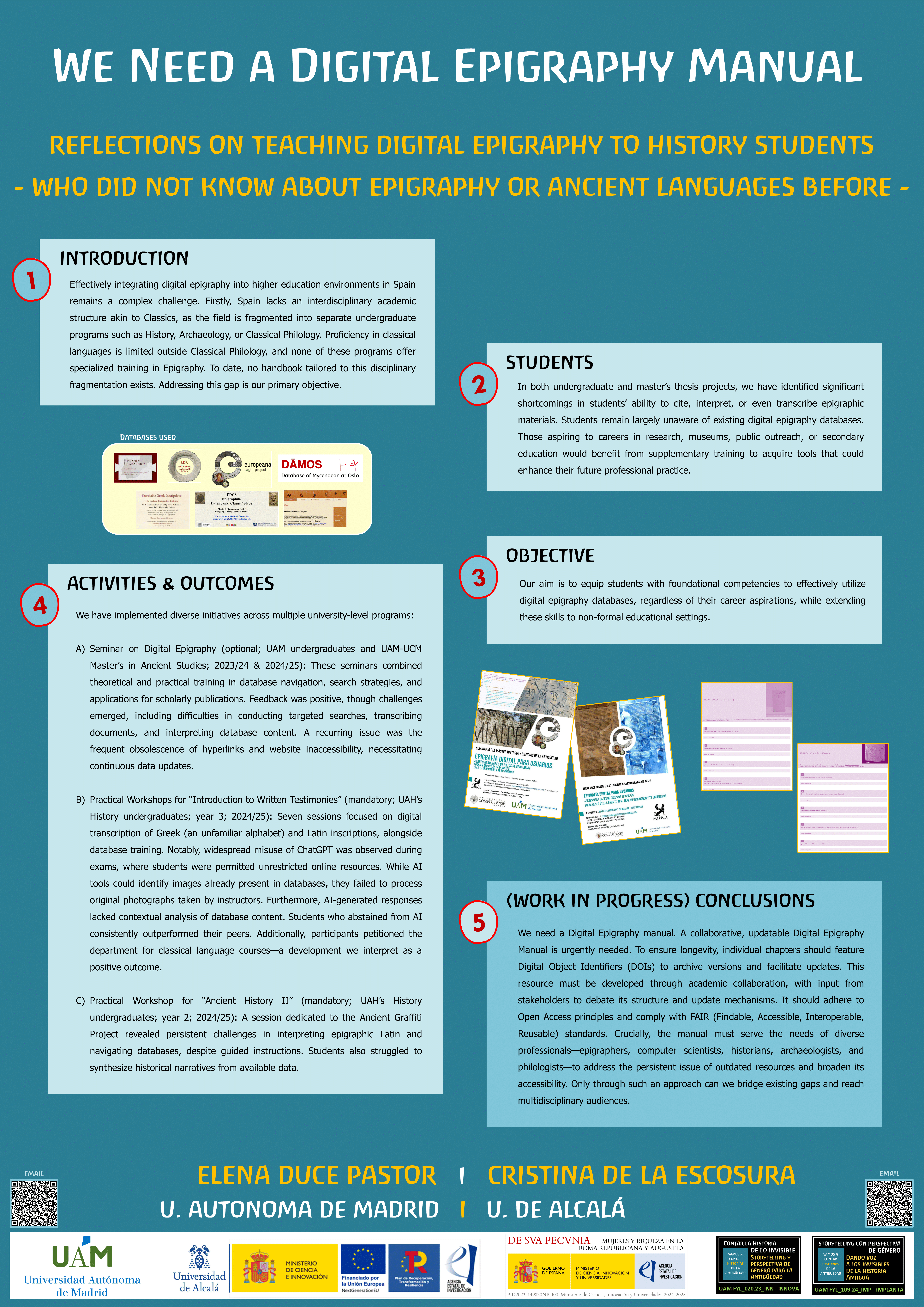
5. TBA
6. NFDI4Objects Community Cluster (CC) Objects as Information Carriers
Christoph Klose (Berlin Coin Collection (Stiftung Preußischer Kulturbesitz) / NFDI4Objects)
c.klose@smb.spk-berlin.de
The Community Cluster Objects as Information Carriers of the National Research Data Infrastructure for Objects (NFDI4Objects) aims to provide an open platform for exchange for all those who conduct research in the field of epigraphy and pursue a material-oriented approach. The central focus of the cluster is the formulation of community-driven recommendations on how to digitally capture objects and inscriptions in a way that best serves the concerns of material-oriented research, adhering to the principles of FAIR and LOD as essential elements for the semantic web. A number of key aspects have already been identified at the regular meetings and workshops organised by the cluster. These include the precise recording of the positioning of the inscription(s) on the object, the relationships of the textual information to the object, to its immediate spatial context (and corresponding objects), to people and places. Other important criteria concern the temporal dimension and sequence of the inscription, as well as its relationship to the object design and decoration. The use of appropriately structured thesauri and vocabularies is essential for this. In a working group of the cluster, digital tools and services from various disciplines are being collected and compared using a checklist to map these criteria. The aim is also to identify ways in which existing resources can be utilised as sustainably as possible, for example through links in the sense of LOD. On the other hand, the results from ongoing projects based on graph-based data modelling can show future-oriented possibilities of how the different media information can be related multimodally for research analyses.
Click here to see the full Poster 6 (PDF)
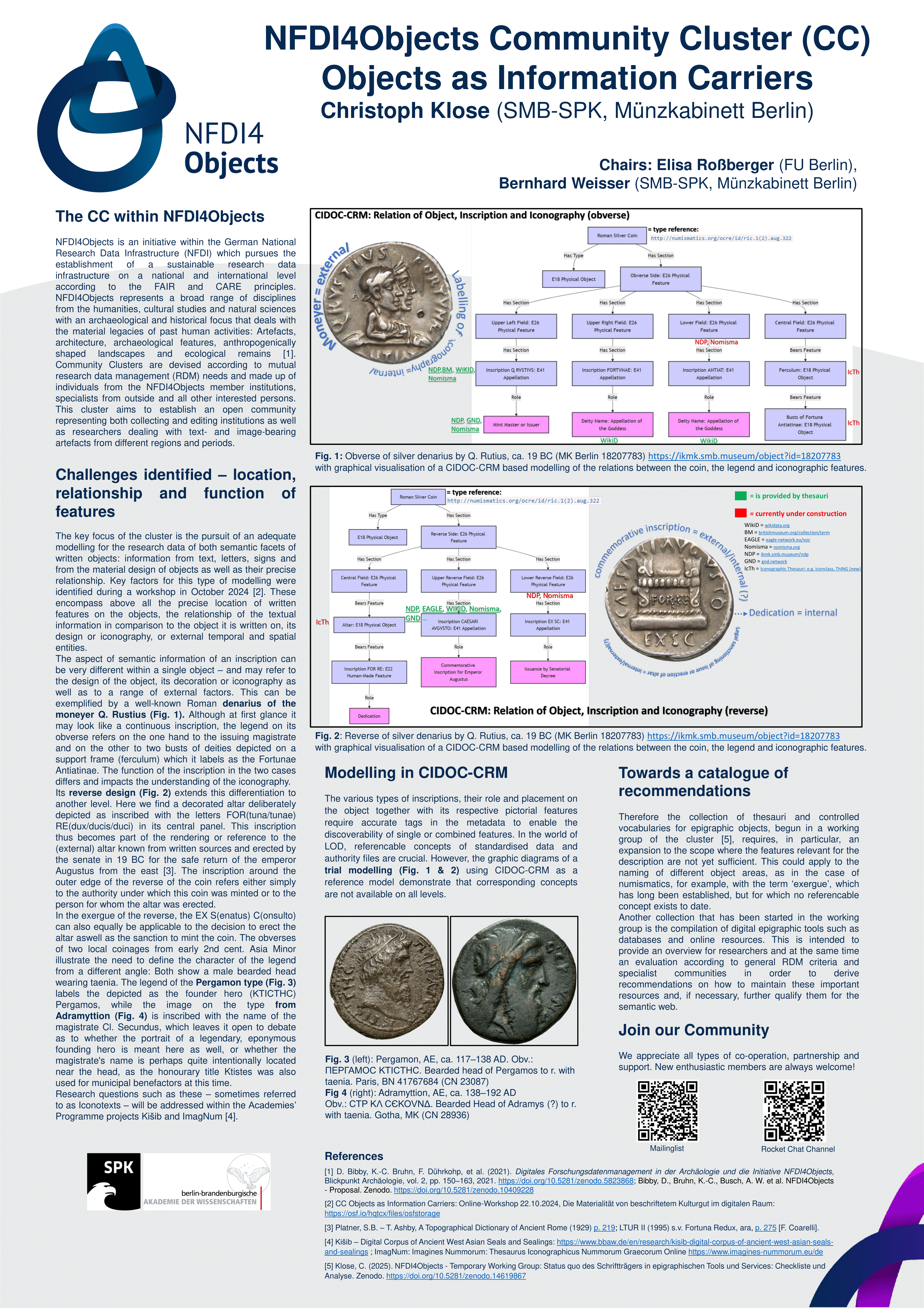
7. STTL
Anamarija Kurilić (University of Zadar, digital poster)
https://zenodo.org/records/15101580
akurilic2011@gmail.com
STTL is a well-known acronym standing for SIT TIBI TERRA LEVIS, and, quite expectedly, it was chosen as the acronym of the research project titled “Sit Tibi Terra Levis: Formulae and Phrases from Funerary Monuments of Ancient Liburnia and Iapodia”. The Project is funded by the Croatian Science Foundation (HRZZ) and shall last for four years (2023–2027). This contribution shall present the project itself, its aims and goals, as well as the results achieved during its first year. The project team will analyse funerary monuments and sites from two northwestern regions of Roman Dalmatia. The main focus will be on epigraphic phrases and formulas, but the research will also focus on content analysis and correlation with other relevant sources (archaeological, linguistic, historical and other), archaeological and spatial analyses, and similar. To achieve that, various methods will be applied using an interdisciplinary and multidisciplinary approach, so, in addition to classical historical and epigraphical methods, methods of digital humanities in general and digital epigraphy in a narrower sense, as well as methods of spatial analysis characteristic of geographical and cartographic research, will also be used. The expected results are multiple, starting with the creation of a thoroughly researched epigraphic corpus and its open access publication. We expect to achieve a better understanding of funeral rituals and the relationship between the living and the dead in the Roman world; also, we expect to detect certain differences between better and stronger Romanized zones (such as Liburnia) and less Romanized ones (such as Iapodia). Hopefully, the achieved results will be a reference for other Roman provincial areas.
Click here to see the full Poster 7 (PDF)
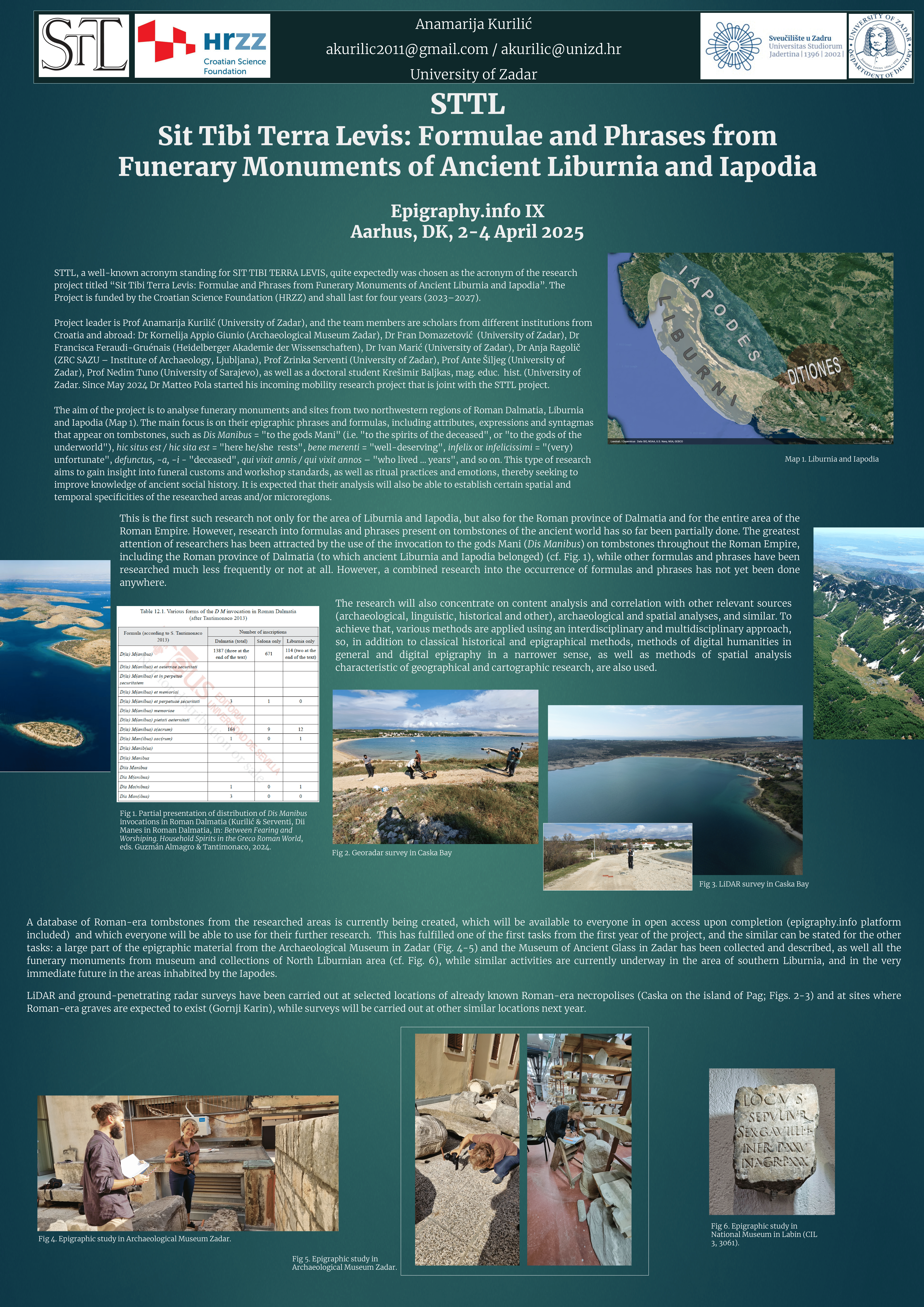
8. Altinum, a Wikidata project for Latin epigraphy and prosopography
Anna Clara Maniero Azzolini (Independent researcher)
azzoliniannaclara@gmail.com
Altinum is the first Latin epigraphy project to be hosted on Wikidata, the collaborative database supported by the Wikimedia Foundation. Launched in 2024, the project involves importing information about epigraphic artefacts from the Roman period originating in Altinum, a municipality in eastern Veneto. The data has been sourced from EDR, EDCS, analogue catalogues, and unpublished theses. In addition to epigraphic data, Altinum also catalogues personal names recorded in Altinum inscriptions, establishing itself as a crucial tool for advanced prosopographical studies of the municipality. Once the data is integrated into the database, users can formulate queries through the Wikidata Query Service (WDQS) to generate graphs and tables, obtain statistics, and reconstruct family trees. In order to talk to the machine and get answered, a good knowledge on SPARQL language is preferably required, but otherwise it would still be possible to manage the query with the aid of the Wikidata Query Builder. To date, the primary field in which the database has been applied is female social network analysis (SNA), starting with an onomastic and prosopographical survey of the female component in Altinum, providing fresh insights. Wikidata offers users a high degree of accessibility to this data, and as Altinum demonstrates, this scientific approach not only expands the epigraphic corpus but also makes it increasingly accessible. All data are accessible under the CC-0 licence and available for consultation on the Zenodo platform.
Click here to see the full Poster 8 (PDF)
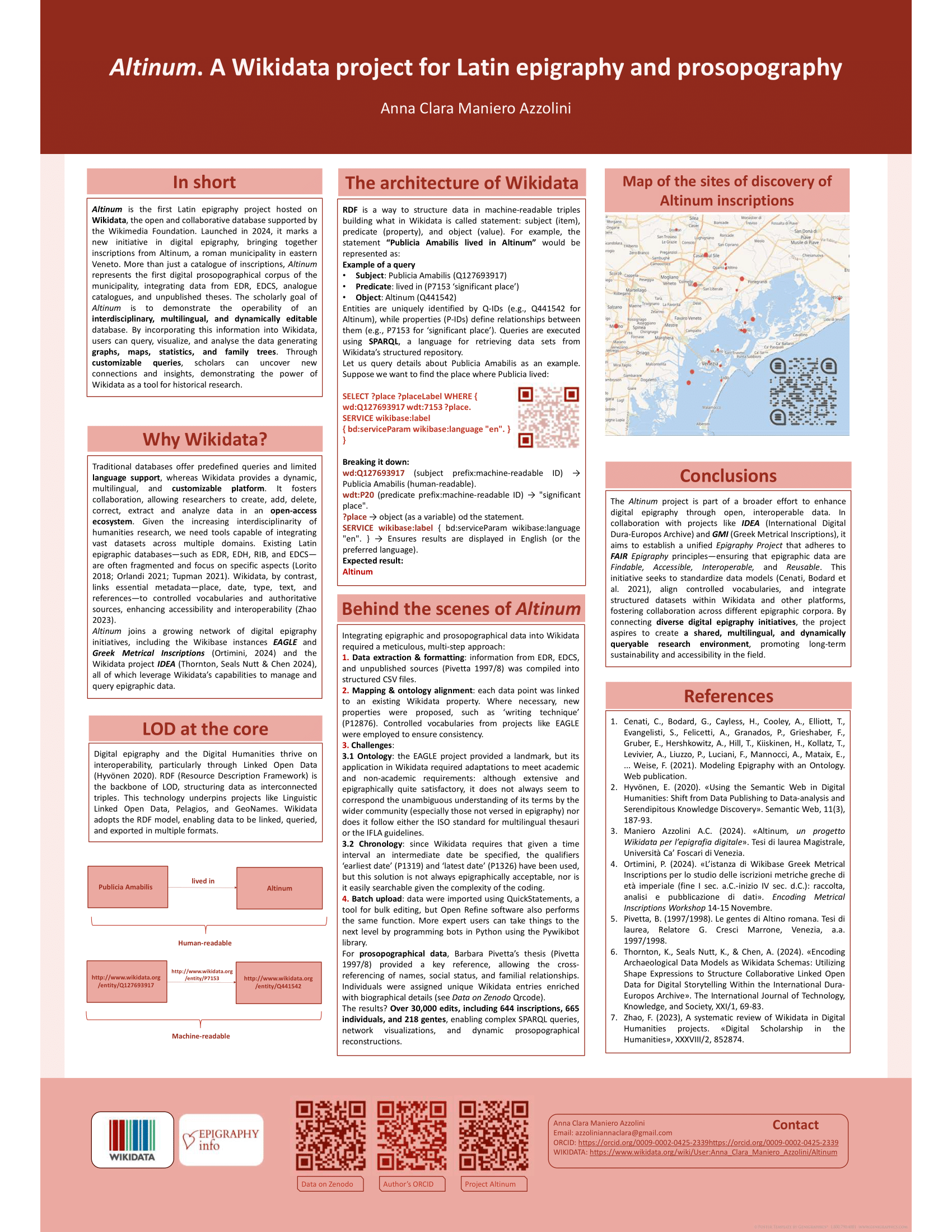
9. The Wikibase instance ‘Greek Metrical Inscriptions’
Pietro Ortimini (University of Pisa)
https://zenodo.org/records/15102921
pietro.ortimini@phd.unipi.it
A rich production of epigraphic poetry written in Greek flourished in the territories of the Graeco-Roman world during the Imperial age (late 1st century BC - early 4th century AD). There is currently no repository that allows for easy collection of data on the inscriptions, which are scattered across various editions. The aim of the Wikibase instance is to gather the Greek metrical inscriptions from the Imperial age into a single collection, providing the following data: edition(s), image(s), geographic provenance, dating, type of inscription, meter, length of the text, objects, layout, clients and recipients, author, external resources (e.g., Trismegistos ID, Wikidata item, Pleiades ID). This data, collected as part of my PhD thesis, is available under the CC BY-SA 4.0 DEED. The data is structured as outlined in the data model and can be queried through SPARQL queries. The data is entered in CSV format through QuickStatements and can be exported in different formats (JSON, TSV, CSV). The Wikibase instance is still a work in progress. The data model is almost complete, queries are being created, and inscriptions are being added (80 inscriptions have been entered so far). As a future perspective, it would be desirable to include the Greek metrical inscriptions from the Archaic, Classical, Hellenistic periods, and Late Antiquity. The aim of this presentation is also to reflect on the use of Wikibase (and Wikidata) for the study of epigraphy.
Click here to see the full Poster 9 (PDF)

10. Epigraphy in situ in Ancient Liburnia and Iapodia: Contextualizing Epigraphic Formulae in the Northwestern Territories of Roman Dalmatia
Matteo Pola (University of Zadar)
matteopola87@gmail.com
As part of the STTL project (Sit Tibi Terra Levis: Formulae and Phrases from the Funerary Monuments of Ancient Liburnia and Iapodia), which examines recurring formulae in Roman funerary epigraphy from the territories of ancient Liburnia and Iapodia in the northwestern regions of the Roman province of Dalmatia, this study—funded by the Croatian Science Foundation (Hrvatska zaklada za znanost)—aims to emphasize the importance of reviewing the contextual data of inscriptions as a key approach to epigraphic material. Reassessing the find contexts of inscriptions and linking them with updated data from recent archaeological investigations often allows us to reconnect museum-held epigraphic artifacts with their original settings, offering crucial historical insights. In addition to providing a framework for the material analysis of inscriptions, this process can reveal whether certain formulae are linked to specific contexts, geographic micro-regions, types of monuments, burial sites, or temporal markers. Such an approach facilitates new groupings of inscriptions and fosters fresh historical interpretations within their original landscapes. By placing epigraphic material within its authentic environmental context and considering the various topographical distributions of certain epigraphic formulae, this research sheds light on the social, cultural, and ritual practices tied to these sites, helping to clarify how epigraphic traditions varied across different regions and periods. Ultimately, the findings will contribute to a comprehensive reconstruction of the epigraphic practices of ancient Liburnia and Iapodia, offering new perspectives on the epigraphic landscape and its significance within the broader historical and cultural framework of Roman Dalmatia.
Click here to see the full Poster 10 (PDF)
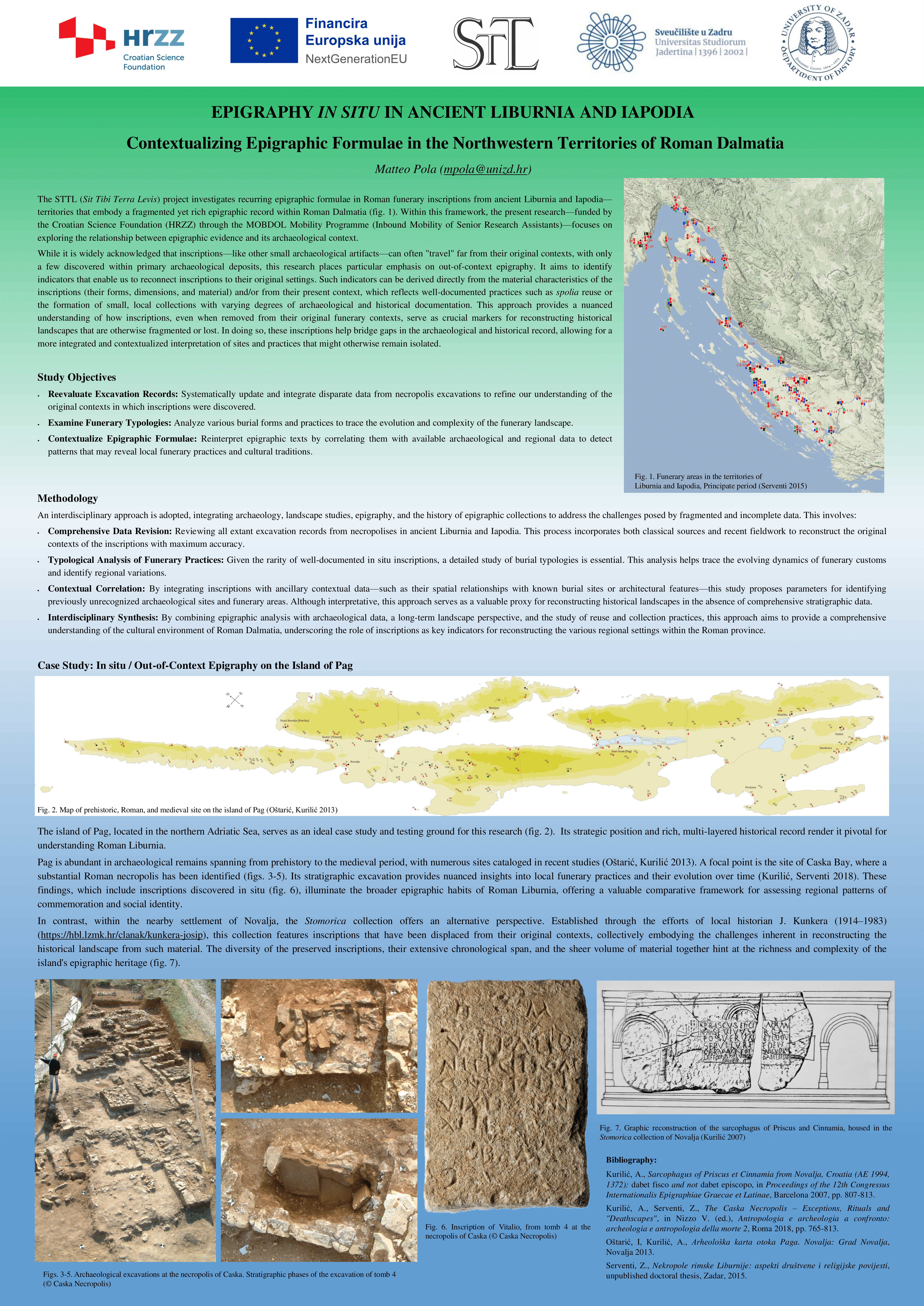
11. La Lettera e il Leone: An Epigraphic Database of Venetian Renaissance Inscriptions from Cyprus
Tatiana Tommasi, Lorenzo Calvelli (University of Udine, Ca’ Foscari University of Venice)
tatiana.tommasi@unive.it
Our poster aims to present the overall contents and structural features of the new online digital resource Venetian Inscriptions in Cyprus. This is the principal output of the research project La Lettera e il Leone, jointly developed by the Ca’ Foscari University of Venice and the Cyprus Institute and mainly devoted to the study and digitisation of epigraphic monuments produced during the Venetian rule of Cyprus (1474-1571). These inscriptions, written in Latin using the Humanistic capital script, were strategically located to showcase Venice’s power and control over the island, as well as to emphasise its political identity. To do so, specific attention has been dedicated to the design of a database with three main features: an important visual apparatus (3D), an interactive map for displaying georeferenced data and a structure compliant with the international standards for encoding epigraphic evidence, especially the EpiDoc guidelines and the FAIR principles. The poster is structured in two parts: firstly, it will show how the database has been created from a theoretical point of view; secondly, it will focus on the contents visible online and on how this resource can contribute to the analysis and dissemination of the epigraphic monuments of Venetian Cyprus. Particular attention will be dedicated to the possibilities of further development of our digital resources and of their interoperability with other online projects.
Click here to see the full Poster 11 (PDF)
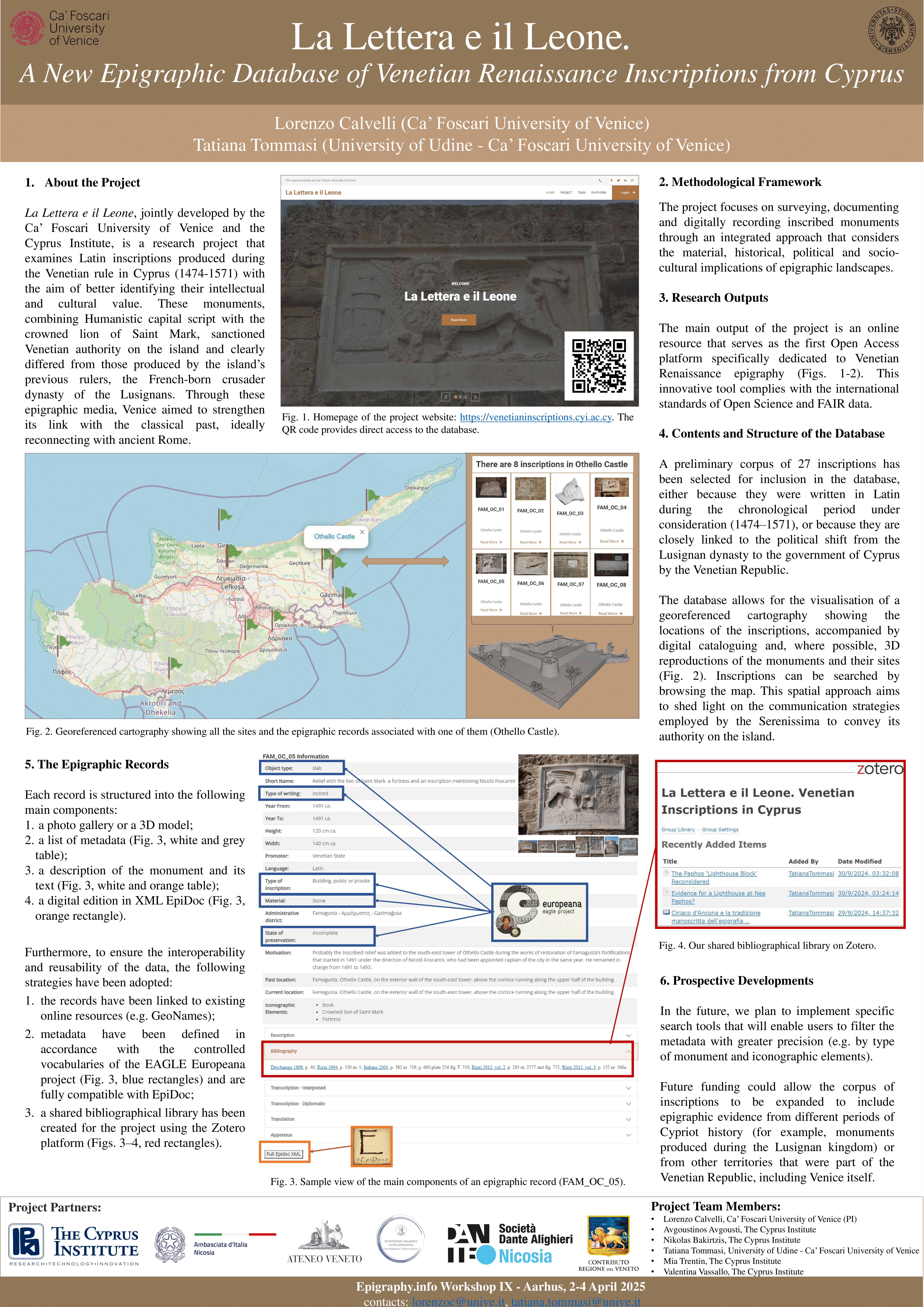
12. Graff-IT Digital Archive: The First Database on Medieval and Early Modern Graffiti in Italy
Antonello Vilella (G. d’Annunzio” University of Chieti-Pescara, digital poster)
https://zenodo.org/records/15063166 __
antonello.vilella@unich.it
In 2022 the ERC Advanced Grant project Graff-IT “Writing on the Margins. Graffiti in Italy (7th – 16th centuries)” began. In its five years of activity, it aims to develop a new interdisciplinary approach to the study of Medieval and early Modern graffiti in Italy, where thousands of monuments and natural caves preserve graffiti, most of which are still undeciphered and/or have only been cursorily studied up until now. By considering together and for the first time the many aspects of this peculiar textual evidence––writing, image, language, and materiality––Graff-IT wishes to become a pioneering experience in the survey and investigation of this vast body of evidence. Its aim is to prove the full dignity of graffiti as written sources and integrate them into the realm of historiographical studies. Achieving these purposes necessarily demands the creation of an online database, which strives to become a point-of-reference for all scholars interested in Medieval and early modern graffiti. The database is currently under development by Net7, an Italian IT company, in strict collaboration with the Graff-IT scientific team. This digital archive is expected to store about 4000 graffiti. Each record will encompass all material, textual, and bibliographical aspects of potential interest to the users, who will also find a rich array of indexes: lemmas, prosopography, places, and lay and religious institutions, to name a few. Lastly, implementations to the database by scholars from outside Graff-IT will be warmly welcomed, as it aims to be an open and constantly evolving digital resource.
Click here to see the full Poster 12 (PDF)
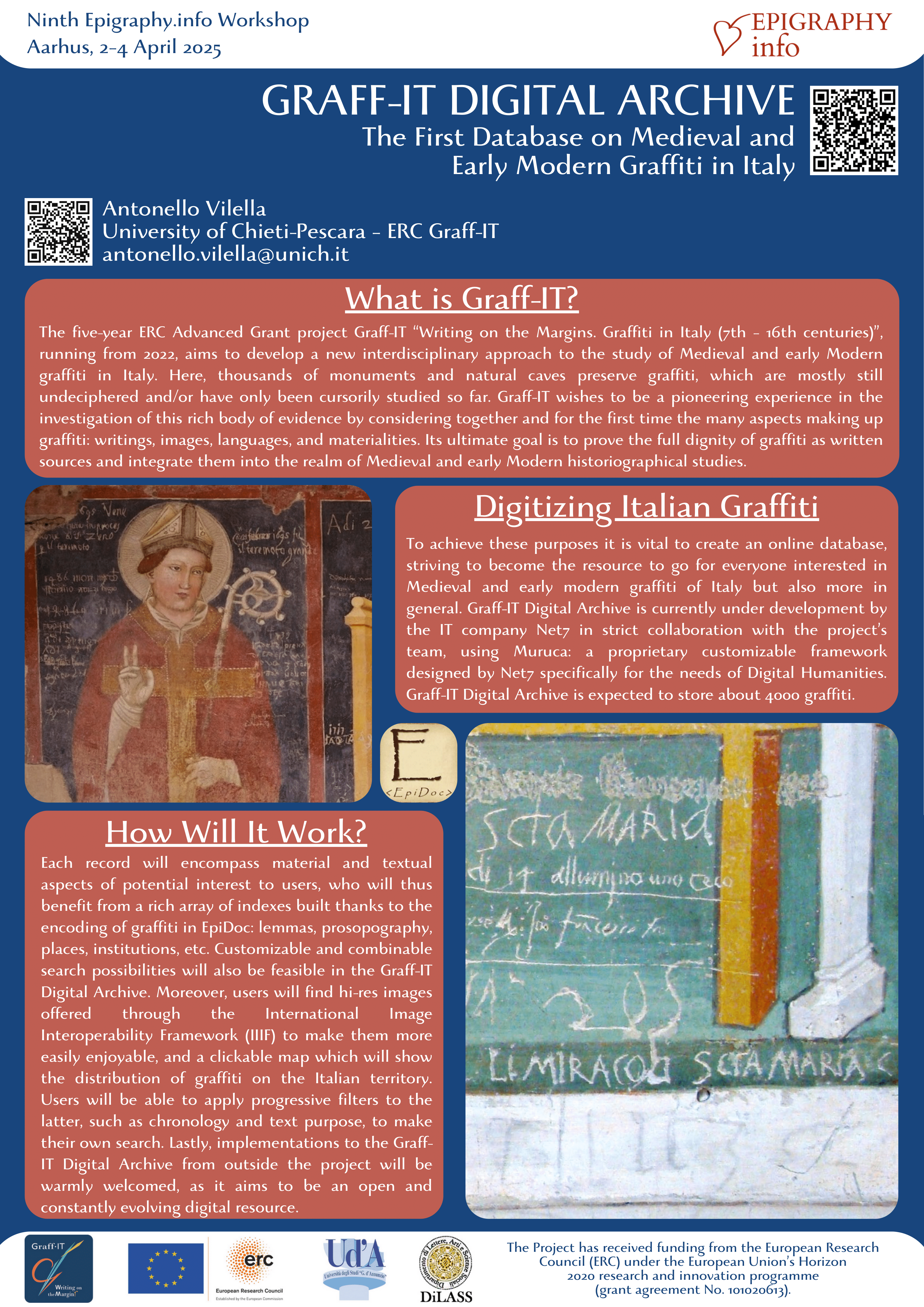
13. Building an epigraphic ontology
Jonathan Prag, Imran Asif, Petra Hermankova, Marietta Horster (FAIR Epigraphy Project, inscriptiones.org)
jonathan.prag@classics.ox.ac.uk
An ontology enables us to tell a computer how the different pieces of data that we have fit together. In turn, this means that individual pieces of data from different projects can be integrated (using the standard RDF language). Several earlier efforts began this process (EpOnt, CRMtex, EpNet). This model builds upon those efforts, and prioritises the use of CIDOC-CRM, which is conceptually rich, very well documented, and widely used. We separate out different parts of the model here, but all these graphs interconnect. The model is deliberately rich/complex to allow for future expansion, but can be simplified.
Click here to see the full Poster 13 (PDF)

–>
